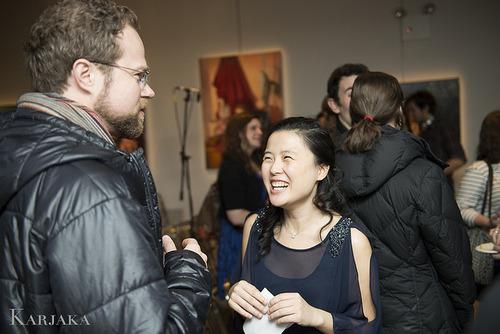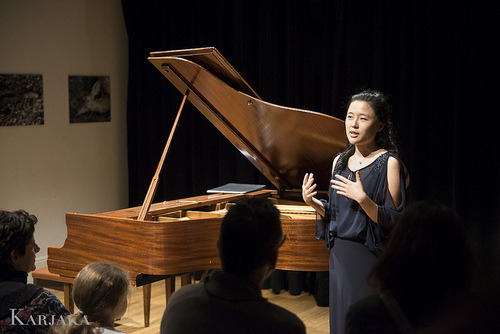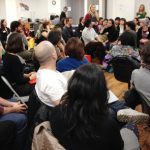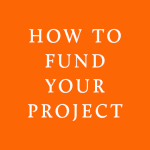Con Edison Immigrant Artist Program Newsletter, Issue No. 58
FEATURED ARTIST: EUNBI KIM, PIANIST
This month, IAP highlights New York City-based pianist and NYFA Artist as Entrepreneur alumnus Eunbi Kim, who produces modern interdisciplinary concert experiences. Kim thrives in collaborating with other art forms to present classical and contemporary music in unique settings. We took the opportunity to learn more about her background, interest in music entrepreneurship and her recent project, “Murakami Music,” a series of multi-disciplinary presentations based on the writings of novelist Haruki Murakami.
Murakami Music was incubated and presented at the cell theatre in Chelsea, and also presented at Symphony Space this past season. It was featured on Japanese television network FujiTV last year, and profiled in the documentary “The World Reads Murakami” on NHK, Japan’s national public broadcasting organization. Kim was a 2012–13 Artist-in-Residence at the cell theatre. She previously produced the multimedia concert “The Third Hand” at The Firehouse Space in Brooklyn, in which piano works were performed alongside projected visual images created by video artist Pyeunghun Baik. Kim made her European orchestral debut with I Solisti di Perugia in Italy, and has also performed solo and chamber programs in venues including the National Museum of Women in the Arts in Washington, D.C. and the 92nd Street Y in New York City. She graduated with a master’s degree from Manhattan School of Music, where she also held a fellowship at the Center for Music Entrepreneurship.
Q: Can you tell us more about your background as a musician? What motivated you to play piano and expand your practice to collaborate with other disciplines?
I’ve been playing piano my whole life, starting from the age of six. I had a tough teacher growing up and parents (read: tiger parents) who were very strict about practicing, so that kept me motivated until college. It seemed natural to continue my studies in college, because it was something that I had been doing for so long. I made an active choice to pursue music as a career only after completing my masters at Manhattan School of Music in 2012.
In 2011, I went to see “Symphony for the Dance Floor” by composer/violinist Daniel Bernard Roumain (DBR) at the Brooklyn Academy of Music. This concert incorporated DBR’s Haitian identity and love for hip-hop, and he collaborated with dancers, a photographer, and a folk singer. It inspired me greatly to see different possibilities within the classical music genre and traditional recital format. I wanted to create performance projects I was passionate about, and collaborate with artists in other disciplines to create new works that gave me an opportunity to share my voice.

Q: Your project “Murakami Music: Stories of Loss and Nostalgia” is inspired by the writings of novelist Haruki Murakami, who writes characters who play piano and reference all types of music, from classical and jazz to the blues. Can you tell us more about how this project came about? What has been most rewarding about the experience so far — and what challenges, if any, did you face as you brought it to life on stage?
I wanted to combine my two passions, music and literature. I had been reading Murakami’s novels for 10 years, and I always imagined a performance adaptation with some of his stories, particularly the ones involving his pianist characters. I started the planning stages while taking a class with Angela Beeching at the Center for Music Entrepreneurship in 2012, and around this time, I was introduced to a great collaborator and actress, Laura Yumi Snell. After the first preview, we started workshopping the piece at the cell theatre — where I did an artist residency — with their Artistic Director, Kira Simring. In November 2013, we performed to a sold-out house at Symphony Space.
Loss is a recurring theme in my ideas and work, and this project speaks to all kinds of loss — loss in identity, sanity, voice, childhood, and innocence. As a Korean-American woman, I’ve also always wanted to confront my feelings about a lot of the images I saw of Asian women in mainstream media. This project allowed me to show Asian women characters on stage portraying real people. I didn’t want this to be the focal point of the performance, so by focusing on loss as the main theme, I knew it could speak to a wider audience.
Aside from watching an idea come into fruition, which is incredibly fulfilling in itself, the most rewarding experience has been all the great relationships I’ve made while working with other artists and meeting people engaged in my work. I also learned a lot that I couldn’t have learned other than experientially: from practical and logistical skills like fundraising and writing proposals, to learning how to navigate business- and human relationships. I’ve also been invited to a lot of interesting opportunities, like publishing a paper for an academic journal and being part of a documentary in Japan.
The biggest challenge is juggling the artistic and administrative aspects of leading a project. There were times when I was more invested in one aspect than the other, and of course, I wanted to only focus on the artistic side, but I also had other responsibilities and people who needed to get paid. During my busiest time, I hired an intern for three months, which helped me a lot.
Q: NYFA was introduced to you in 2012 through your participation in the Artist as Entrepreneur program, organized in collaboration with New York University’s program in performing arts administration. You also received a fellowship from the Center for Music Entrepreneurship at Manhattan School of Music. Drawing on these experiences, what attributes do you think successful entrepreneurs have? What impact do you think it can have on one’s artistic career? And are there any takeaways that you could share with our immigrant artist community?
Successful entrepreneurs are doers, not thinkers. An idea is worth nothing if there’s no action behind it. They do all the unglamorous, dirty work that no one wants to do. They invest in their projects; you need money to make money. Immigrants have an advantage: we understand WORK. Where we sometimes fall short is in our soft skills. The most successful entrepreneurs are expert communicators in networking and negotiating. Every culture has different nuances in communicating, both in social and professional settings; it’s highly advisable to learn about the culture you’re in and adapt accordingly.
If every artist were more entrepreneurial, they would be better informed about the business aspects of art, be more creative and artistically fulfilled, and build more opportunities for themselves and others within the community. Given the changing climate of how the arts are being funded, this would make an incredible impact in empowering every individual to be creative in how they share and make money from their art.
It’s important to remember that New York City has one of the largest immigrant populations in the country, with an already rich history of immigration in general. It also has one of the most vibrant cultural scenes in the entire world. The immigrant artist community can offer both a unique and universal perspective to an audience that is there and wants to hear your voice.
Q: Many of our immigrant artists have recently relocated to New York City. Do you have any advice about living and working in NYC? What challenges do you encounter relative to your discipline or the arts in general? Have you found solutions to counterbalance life in the city?
First and foremost, be generous and kind. Be active within the community, and support your fellow artists by going to shows and contributing to their work. By establishing authentic relationships with other professionals and patrons in the arts, you’ll steadily grow a network of people who support your work and can refer you to great opportunities.
Other words of advice: Don’t ever bad-mouth any of your colleagues. It’s advisable not to burn any bridges; no relationship is irreparable. Be a consummate professional for all engagements, regardless of whether they’re paid or not, or who will be in the audience, etc.
The biggest challenge of living and working in New York City is balancing finances and time, which go hand-in-hand. You need enough time dedicated to your work as an artist, but you also have to pay your rent. If your art can’t support your life just yet, the goal is to figure out how to create a life that could help support your art in the meantime. I’ve chosen to start a piano studio, and also freelance as an events producer. Instead of a traditional day job, I’ve opted to make more per hour and have a flexible schedule. But everyone is different, and there are pros and cons for any which way.

Q: Where can our artists follow your work and be informed about your upcoming projects?
Please visit my website, where you can also contact me directly or via social media sites. You can also sign up for my newsletter, which I send sporadically, with updates and special offers for upcoming performances. Thanks for your interest and time.





